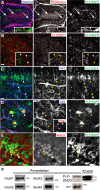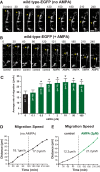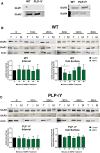Myelin Proteolipid Protein Complexes with αv Integrin and AMPA Receptors In Vivo and Regulates AMPA-Dependent Oligodendrocyte Progenitor Cell Migration through the Modulation of Cell-Surface GluR2 Expression
- PMID: 26311781
- PMCID: PMC4549408
- DOI: 10.1523/JNEUROSCI.5151-14.2015
Myelin Proteolipid Protein Complexes with αv Integrin and AMPA Receptors In Vivo and Regulates AMPA-Dependent Oligodendrocyte Progenitor Cell Migration through the Modulation of Cell-Surface GluR2 Expression
Abstract
In previous studies, stimulation of ionotropic AMPA/kainate glutamate receptors on cultured oligodendrocyte cells induced the formation of a signaling complex that includes the AMPA receptor, integrins, calcium-binding proteins, and, surprisingly, the myelin proteolipid protein (PLP). AMPA stimulation of cultured oligodendrocyte progenitor cells (OPCs) also caused an increase in OPC migration. The current studies focused primarily on the formation of the PLP-αv integrin-AMPA receptor complex in vivo and whether complex formation impacts OPC migration in the brain. We found that in wild-type cerebellum, PLP associates with αv integrin and the calcium-impermeable GluR2 subunit of the AMPA receptor, but in mice lacking PLP, αv integrin did not associate with GluR2. Live imaging studies of OPC migration in ex vivo cerebellar slices demonstrated altered OPC migratory responses to neurotransmitter stimulation in the absence of PLP and GluR2 or when αv integrin levels were reduced. Chemotaxis assays of purified OPCs revealed that AMPA stimulation was neither attractive nor repulsive but clearly increased the migration rate of wild-type but not PLP null OPCs. AMPA receptor stimulation of wild-type OPCs caused decreased cell-surface expression of the GluR2 AMPA receptor subunit and increased intracellular Ca(2+) signaling, whereas PLP null OPCs did not reduce GluR2 at the cell surface or increase Ca(2+) signaling in response to AMPA treatment. Together, these studies demonstrate that PLP is critical for OPC responses to glutamate signaling and has important implications for OPC responses when levels of glutamate are high in the extracellular space, such as following demyelination.
Significance statement: After demyelination, such as occurs in multiple sclerosis, remyelination of axons is often incomplete, leading to loss of neuronal function and clinical disability. Remyelination may fail because oligodendrocyte precursor cells (OPCs) do not completely migrate into demyelinated areas or OPCs in lesions may not mature into myelinating oligodendrocytes. We have found that the myelin proteolipid protein is critical to regulating OPC migratory responses to the neurotransmitter glutamate through modulation of cell-surface expression of the calcium-impermeable GluR2 subunit of the AMPA glutamate receptor and increased intercellular Ca(2+) signaling. Altered glutamate homeostasis has been reported in demyelinated lesions. Therefore, understanding how OPCs respond to glutamate has important implications for treatment after white matter injury and disease.
Keywords: AMPA; GluR2; integrin; migration; myelin proteolipid protein; oligodendrocyte.
Copyright © 2015 the authors 0270-6474/15/3512018-15$15.00/0.
Figures









Similar articles
-
Glutamate Signaling via the AMPAR Subunit GluR4 Regulates Oligodendrocyte Progenitor Cell Migration in the Developing Spinal Cord.J Neurosci. 2021 Jun 23;41(25):5353-5371. doi: 10.1523/JNEUROSCI.2562-20.2021. Epub 2021 May 11. J Neurosci. 2021. PMID: 33975920 Free PMC article.
-
Glutamate stimulates oligodendrocyte progenitor migration mediated via an alphav integrin/myelin proteolipid protein complex.J Neurosci. 2006 Mar 1;26(9):2458-66. doi: 10.1523/JNEUROSCI.4054-05.2006. J Neurosci. 2006. PMID: 16510724 Free PMC article.
-
Expression of proteolipid protein gene in spinal cord stem cells and early oligodendrocyte progenitor cells is dispensable for normal cell migration and myelination.J Neurosci. 2014 Jan 22;34(4):1333-43. doi: 10.1523/JNEUROSCI.2477-13.2014. J Neurosci. 2014. PMID: 24453324 Free PMC article.
-
Matrix metalloproteinases shape the oligodendrocyte (niche) during development and upon demyelination.Neurosci Lett. 2020 Jun 11;729:134980. doi: 10.1016/j.neulet.2020.134980. Epub 2020 Apr 19. Neurosci Lett. 2020. PMID: 32315713 Review.
-
Engineering biomaterial microenvironments to promote myelination in the central nervous system.Brain Res Bull. 2019 Oct;152:159-174. doi: 10.1016/j.brainresbull.2019.07.013. Epub 2019 Jul 12. Brain Res Bull. 2019. PMID: 31306690 Review.
Cited by
-
Insights Into Central Nervous System Glial Cell Formation and Function From Zebrafish.Front Cell Dev Biol. 2021 Nov 29;9:754606. doi: 10.3389/fcell.2021.754606. eCollection 2021. Front Cell Dev Biol. 2021. PMID: 34912801 Free PMC article. Review.
-
Embracing oligodendrocyte diversity in the context of perinatal injury.Neural Regen Res. 2017 Oct;12(10):1575-1585. doi: 10.4103/1673-5374.217320. Neural Regen Res. 2017. PMID: 29171412 Free PMC article. Review.
-
Ca2+ -permeable AMPA receptors and their auxiliary subunits in synaptic plasticity and disease.J Physiol. 2021 May;599(10):2655-2671. doi: 10.1113/JP279029. Epub 2021 Feb 21. J Physiol. 2021. PMID: 33533533 Free PMC article.
-
Lipoprotein Lipase Is a Feature of Alternatively-Activated Microglia and May Facilitate Lipid Uptake in the CNS During Demyelination.Front Mol Neurosci. 2018 Mar 15;11:57. doi: 10.3389/fnmol.2018.00057. eCollection 2018. Front Mol Neurosci. 2018. PMID: 29599706 Free PMC article.
-
Glutamate Signaling via the AMPAR Subunit GluR4 Regulates Oligodendrocyte Progenitor Cell Migration in the Developing Spinal Cord.J Neurosci. 2021 Jun 23;41(25):5353-5371. doi: 10.1523/JNEUROSCI.2562-20.2021. Epub 2021 May 11. J Neurosci. 2021. PMID: 33975920 Free PMC article.
References
-
- Barres BA, Lazar MA, Raff MC. A novel role for thyroid hormone, glucocorticoids and retinoic acid in timing oligodendrocyte development. Development. 1994;120:1097–1108. - PubMed
Publication types
MeSH terms
Substances
Grants and funding
LinkOut - more resources
Full Text Sources
Medical
Molecular Biology Databases
Research Materials
Miscellaneous
